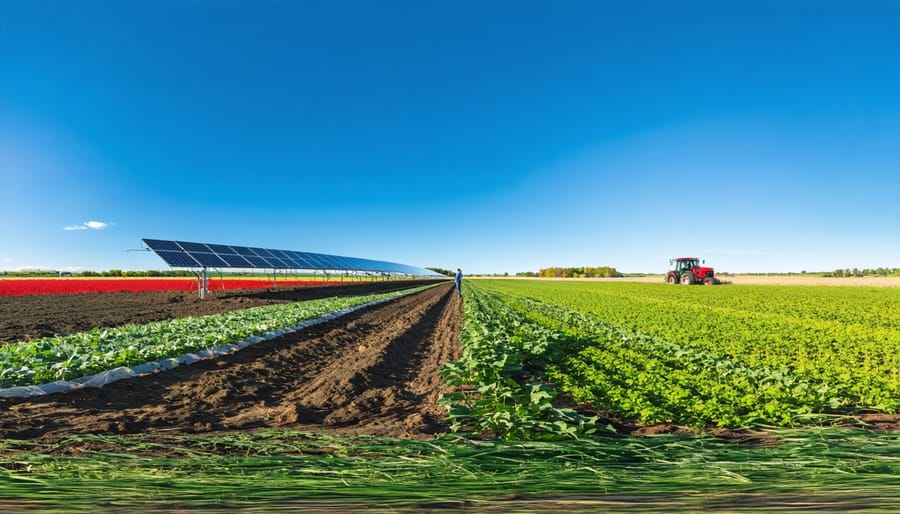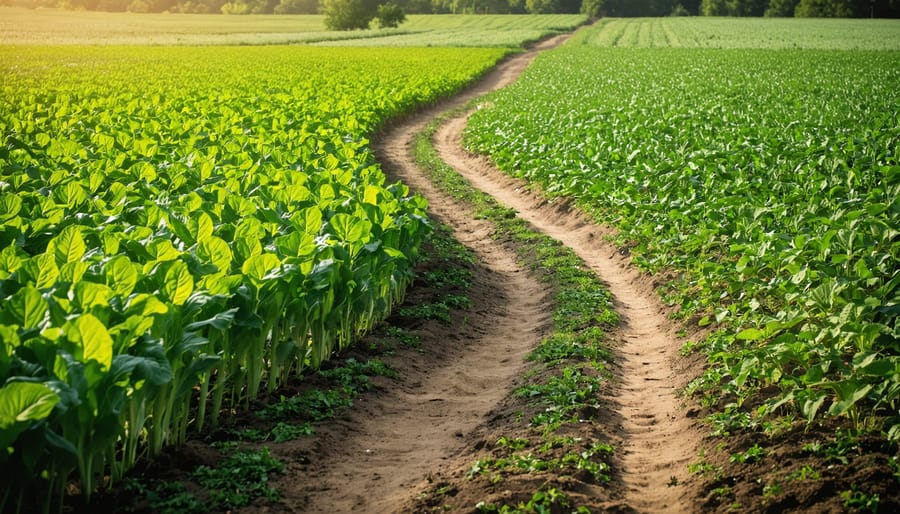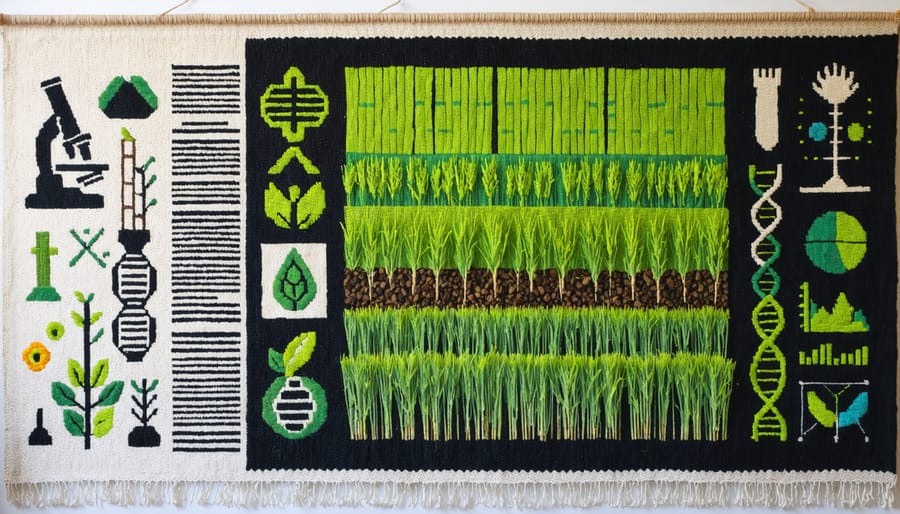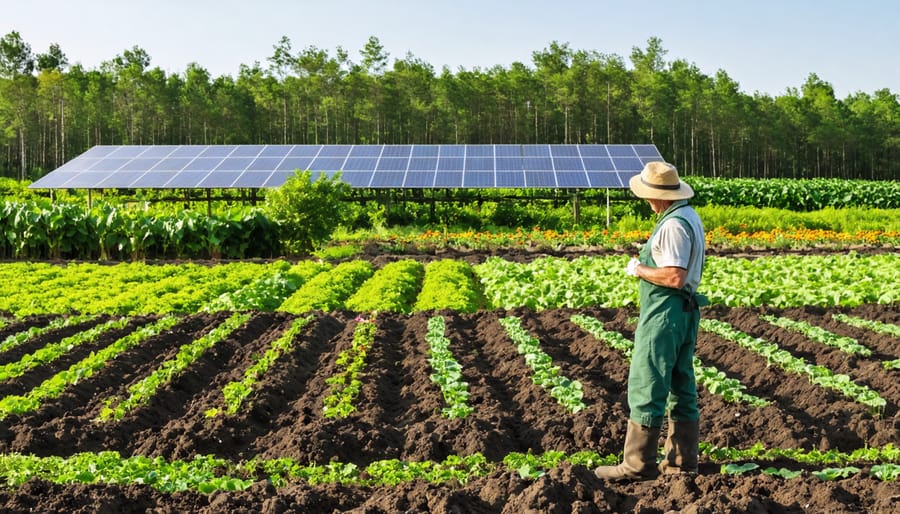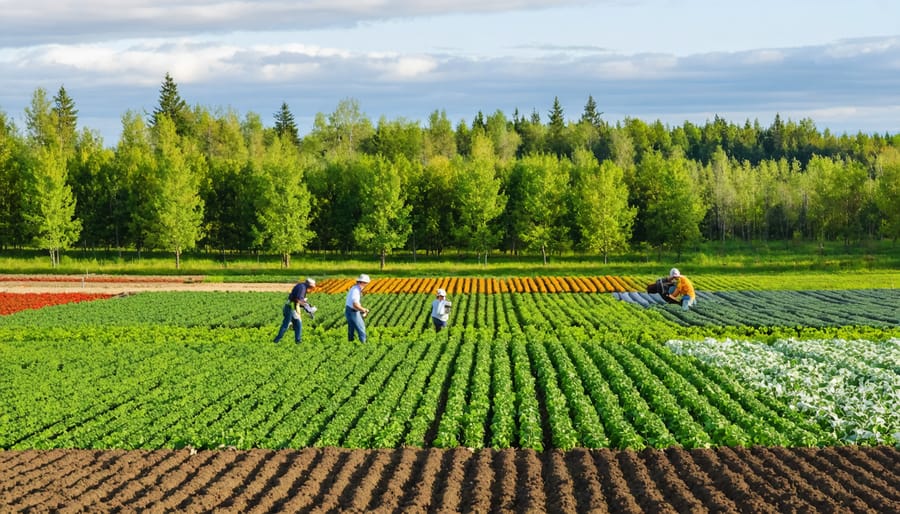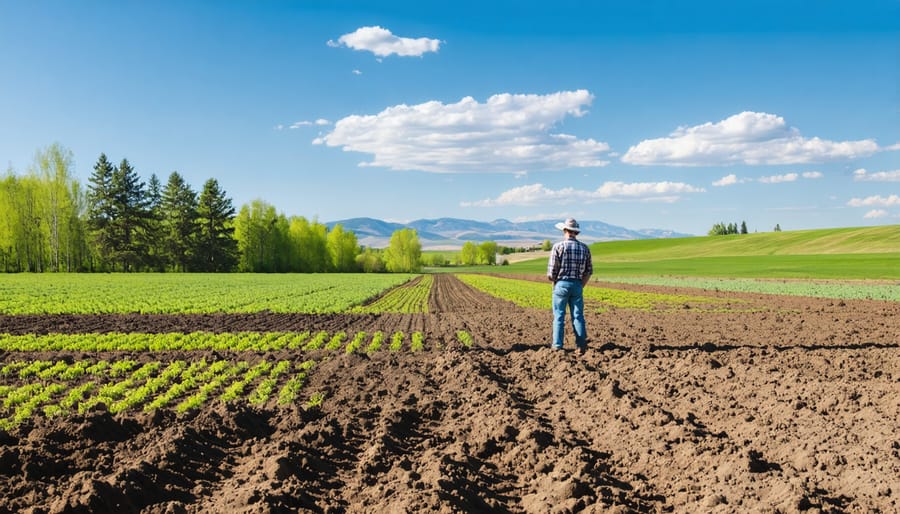Implement conservation tillage to reduce soil disturbance, improve soil structure, and enhance carbon sequestration. Adopt crop rotation and cover cropping to optimize nutrient cycling, suppress weeds, and build soil health. Utilize precision agriculture technologies like variable rate application and GPS guidance to minimize inputs and maximize efficiency. Integrate agroforestry practices such as shelterbelts and silvopasture to diversify income streams, provide habitat, and mitigate climate impacts.
Regenerative Soil Management
Cover Cropping
Cover cropping is a powerful climate-smart agricultural practice that offers numerous benefits for Albertan farmers. By planting cover crops between primary crop rotations, farmers can improve soil health, reduce erosion, and enhance nutrient cycling. Cover crops, such as legumes, grasses, and brassicas, protect the soil from wind and water erosion, while their root systems help maintain soil structure and promote water infiltration.
One of the key advantages of cover cropping is its ability to sequester carbon in the soil, contributing to the mitigation of greenhouse gas emissions. As cover crops grow, they absorb atmospheric carbon dioxide and store it in their biomass and the soil. When the cover crops decompose, they add organic matter to the soil, further improving its carbon content and fertility.
To effectively implement cover cropping in Alberta, farmers should consider factors such as the local climate, soil type, and primary crop rotation. Selecting the right cover crop species is crucial to maximize benefits and avoid potential challenges. For example, leguminous cover crops, like clover and vetch, can fix atmospheric nitrogen, reducing the need for synthetic fertilizers. In contrast, grasses, such as rye and oats, are excellent at suppressing weeds and improving soil structure.
Timing is also essential when implementing cover cropping. Planting cover crops immediately after harvesting the primary crop allows them to establish well before winter, providing better soil protection and nutrient capture. Farmers can terminate cover crops through various methods, such as mowing, tillage, or herbicide application, depending on their specific goals and the following primary crop.
By adopting cover cropping as part of a comprehensive climate-smart agricultural strategy, Albertan farmers can enhance the resilience and sustainability of their operations while contributing to the global effort to mitigate climate change.
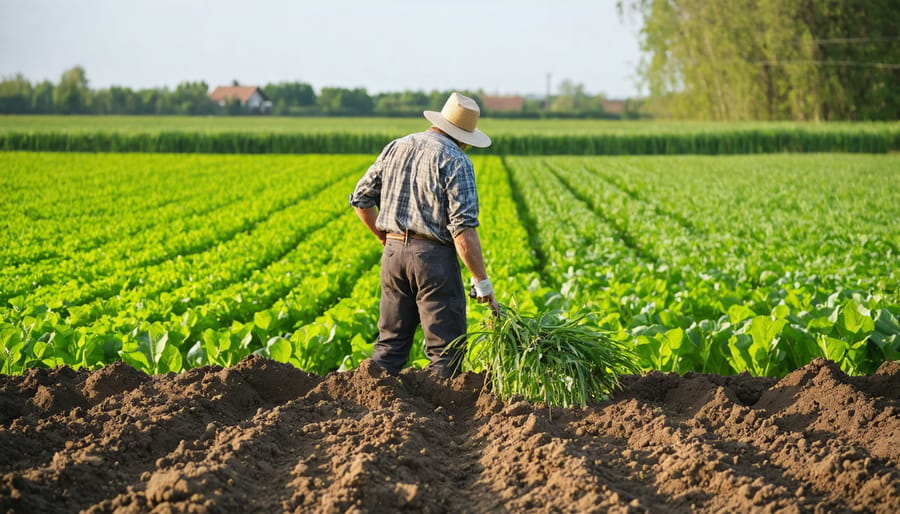
Reduced Tillage
Reduced tillage is a cornerstone of climate-smart agriculture, offering numerous benefits for soil health and greenhouse gas mitigation. By minimizing soil disturbance, reduced tillage helps maintain soil structure, increase water retention, and reduce erosion. This practice also promotes the growth of beneficial soil microbes, enhances nutrient cycling, and improves overall soil fertility.
Adopting reduced tillage can be a gradual process, starting with strategies like strip-tillage or ridge-tillage before transitioning to no-till. Farmers can invest in specialized equipment, such as no-till seed drills, to facilitate planting without extensive soil disturbance. Cover cropping, as discussed earlier, complements reduced tillage by protecting the soil surface and adding organic matter.
When implementing reduced tillage, it’s essential to manage crop residues effectively, as they can sometimes impede planting or harbor pests. Residue management techniques, like chopping or spreading, can help distribute residues evenly across the field. Farmers should also monitor soil compaction and address any issues through targeted subsoiling or planting deep-rooted cover crops.
By embracing reduced tillage, Canadian farmers can build healthier, more resilient soils while reducing their carbon footprint. Local agricultural extension services and farmer networks can provide valuable guidance and support for those looking to adopt this climate-smart practice on their operations.
Precision Nutrient Management
Soil Testing
Soil testing is a crucial practice for climate-smart agriculture, as it provides valuable insights into your soil’s nutrient levels and health. By regularly testing your soil, you can make informed decisions about nutrient management, ensuring that you apply the right amounts of fertilizers or amendments to meet your crops’ needs without overuse. Interpreting soil test results allows you to identify nutrient deficiencies or excesses, pH imbalances, and organic matter content. Armed with this knowledge, you can tailor your nutrient application strategies to optimize plant growth, minimize waste, and reduce the risk of nutrient runoff or leaching, which can contribute to environmental issues like water pollution. Soil testing also helps you monitor changes in soil health over time, enabling you to adjust your practices as needed to maintain the long-term productivity and sustainability of your farm. By embracing regular soil testing, Canadian farmers can play a vital role in promoting climate-smart agriculture and stewarding our land for future generations.
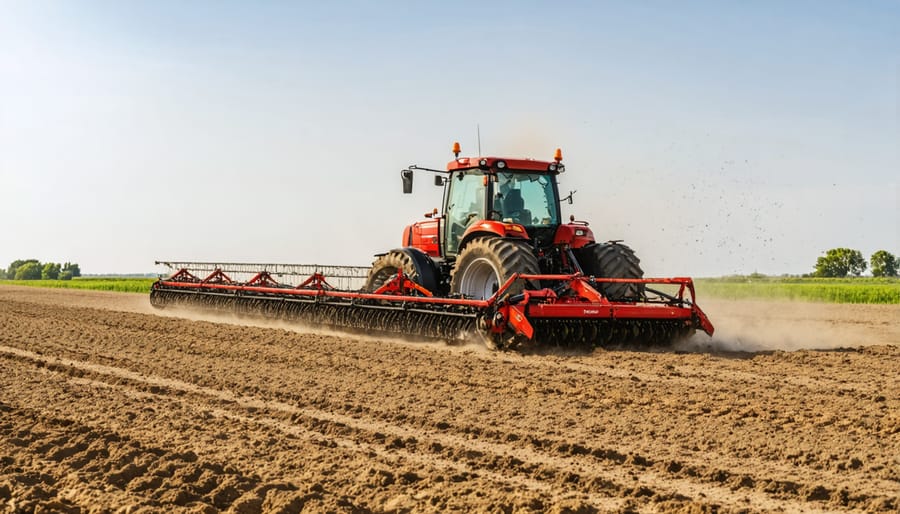
Variable Rate Technology
Variable rate technology (VRT) is a precision agriculture tool that enables farmers to optimize nutrient application based on crop-specific needs. By using GPS-guided equipment and detailed soil maps, VRT systems can adjust fertilizer rates in real-time as the applicator moves across the field. This targeted approach reduces over-application and nutrient runoff, minimizing environmental impact while saving on input costs.
VRT also allows for site-specific management, accounting for variations in soil type, fertility, and yield potential within a single field. Farmers can input data from soil tests, yield maps, and remote sensing to create prescription maps that guide variable rate applications. This tailored nutrient management strategy promotes more efficient use of resources, healthier crops, and improved soil quality over time.
Adopting VRT as part of a comprehensive climate-smart agriculture plan can help Canadian farmers boost productivity, profitability, and environmental stewardship. By fine-tuning nutrient inputs to match crop requirements, producers can optimize plant growth while reducing their carbon footprint and protecting local ecosystems.
Integrated Pest Management
Biological Control
Biological control is a climate-smart agricultural practice that harnesses the power of beneficial insects and microorganisms to naturally suppress pests. By introducing or encouraging the presence of predatory insects, parasitic wasps, and beneficial fungi or bacteria, farmers can effectively manage pest populations without relying on synthetic pesticides. This approach not only reduces the environmental impact of pest control but also promotes biodiversity and ecosystem health.
In Alberta, farmers have successfully used biological control to manage pests like aphids, thrips, and spider mites in greenhouses and field crops. For example, ladybugs and lacewings prey on aphids, while certain species of parasitic wasps lay their eggs inside pest larvae, effectively controlling their populations. Beneficial fungi like Beauveria bassiana can infect and kill various insect pests, providing a natural and targeted solution.
Implementing biological control requires careful planning and monitoring, as well as an understanding of the specific pests and their natural enemies. Working with local agricultural experts and organizations can help farmers develop effective strategies tailored to their unique needs and ecosystems. By embracing biological control as part of a holistic, climate-smart approach to agriculture, Canadian farmers can build more resilient and sustainable food systems for the future.
Targeted Spraying
Targeted spraying is a precision technique that optimizes pesticide application by focusing on specific areas and times when pests are most active or vulnerable. By using advanced monitoring systems and predictive models, farmers can identify key intervention points and adjust spraying schedules accordingly. This approach not only reduces overall pesticide use but also improves coverage and effectiveness. For example, a study in Alberta found that targeted spraying of canola fields based on pest thresholds reduced insecticide applications by 30% while maintaining yields. Innovations like GPS-guided sprayers and variable-rate nozzles further enhance accuracy and minimize drift. Adopting targeted spraying practices not only benefits the environment but also helps farmers save on input costs and comply with regulations. As Canadian farmers continue to prioritize sustainability, targeted spraying will play an increasingly important role in climate-smart agriculture.
Agroforestry Systems
Shelterbelts
Shelterbelts, strategically planted rows of trees and shrubs, offer numerous benefits for climate-smart agriculture in Alberta. These living windbreaks protect crops from erosion by reducing wind speed and soil loss. They also create microclimates that moderate temperature extremes, potentially increasing crop yields. Shelterbelts provide valuable habitat for pollinators and other beneficial wildlife, promoting biodiversity on farms.
Properly designed shelterbelts can trap snow, increasing soil moisture for crops come spring. They also sequester carbon, contributing to greenhouse gas mitigation efforts. Many Alberta farmers have found that shelterbelts reduce energy costs by shielding buildings from wind and sun. With careful planning and maintenance, shelterbelts are a win-win solution that enhances the sustainability and resilience of agricultural operations while providing ecosystem services. Albertan farmers can access resources and funding through programs like ALUS to support shelterbelt establishment on their land.
Silvopasture
Silvopasture, a climate-smart agricultural practice, offers Canadian farmers a way to integrate trees with livestock grazing for multiple benefits. By strategically planting trees in pastures, farmers can provide shade and shelter for animals, reducing heat stress and improving animal welfare. Trees also help to prevent soil erosion, enhance water retention, and sequester carbon. Silvopasture systems can increase biodiversity by providing habitat for wildlife and pollinators. Moreover, this practice diversifies farm income through the production of timber, fruits, nuts, or other tree products. Successful examples in Alberta, such as the Aspen Parkland Silvopasture Project, demonstrate the potential for increased profitability and sustainability. Implementing silvopasture requires careful planning and management, including selecting the right tree species, spacing, and grazing strategies. With proper implementation, silvopasture can be a valuable tool for Canadian farmers looking to enhance their land’s productivity and resilience while contributing to climate change mitigation.
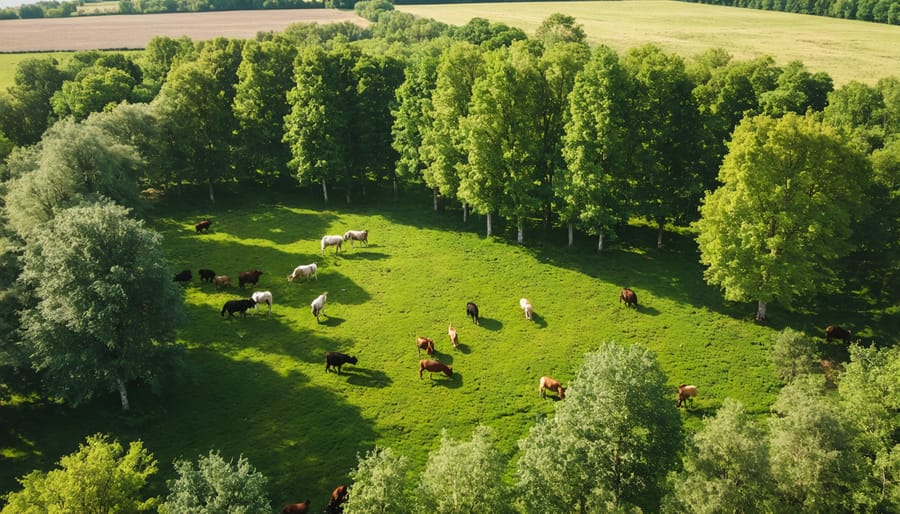
Renewable Energy Integration
Solar-Powered Irrigation
Solar-powered irrigation offers a sustainable and cost-effective solution for Canadian farmers looking to optimize their water management practices. By harnessing the power of the sun, solar panels can efficiently operate irrigation systems, reducing reliance on fossil fuels and minimizing energy costs. This technology is particularly well-suited to the sunny climate of Alberta, where solar energy is abundant during the growing season. Farmers can install solar panels near their irrigation systems, storing excess energy in batteries for use during cloudy periods or at night. Solar-powered irrigation not only contributes to reducing greenhouse gas emissions but also provides farmers with greater energy independence and resilience against power outages. As an added benefit, by reducing energy expenses, solar-powered irrigation can help improve the overall financial sustainability of farm operations. Embracing this climate-smart practice demonstrates a commitment to environmental stewardship while ensuring the long-term viability of agricultural production in Canada.
On-Farm Biogas Production
On-farm biogas production is a sustainable solution that converts agricultural waste, such as manure and crop residues, into renewable energy and valuable by-products. By capturing methane emissions from decomposing organic matter, farmers can generate electricity, heat, and fuel while reducing greenhouse gas emissions. The process also produces nutrient-rich digestate, which can be used as a natural fertilizer to improve soil health and crop yields. Implementing biogas systems not only enhances a farm’s environmental performance but also creates new revenue streams and cost savings. As a climate-smart practice, on-farm biogas production contributes to a circular economy, minimizing waste and optimizing resource efficiency. With support from government incentives and industry partnerships, more Canadian farmers are adopting this technology to boost their sustainability efforts and strengthen the resilience of their operations in the face of climate change.
Conclusion
Climate-smart agriculture offers a promising pathway for Albertan farmers to enhance sustainability, resilience, and profitability in the face of climate change. By adopting practices such as conservation tillage, cover cropping, precision agriculture, and integrated pest management, farmers can reduce their environmental impact while improving soil health, water conservation, and crop yields. The benefits extend beyond individual farms, as these practices contribute to the well-being of local communities and ecosystems. As stewards of the land, Albertan farmers have a unique opportunity to lead the way in climate-smart agriculture, setting an example for the rest of Canada and the world. By embracing these practices and sharing knowledge with one another, we can build a more sustainable and resilient agricultural future for generations to come. The time to act is now – let’s work together to make climate-smart agriculture the norm in Alberta and beyond.

